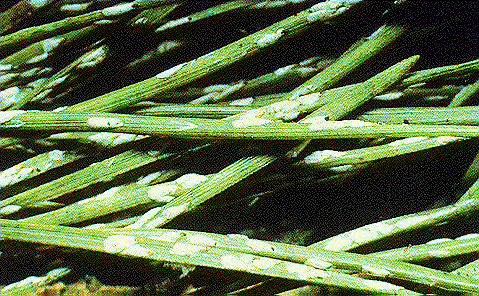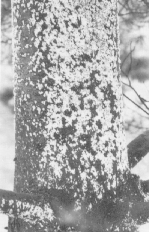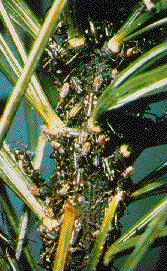Common Sap Feeding Pine Pests
ENTFACT-412: Common Sap Feeding Pine Pests | Download PDF
by Joe T. Collins and Lee Townsend, Entomologists
University of Kentucky College of Agriculture
Pines are popular for landscape plantings in Kentucky as both foundation landscape plantings and ind screens. They seem to be favored because of their fairly uniform, rapid growth and easy maintenance. However, some insects can build up to large numbers on these trees with striking results. Those that feed with sucking mouthparts remove plant sap. Symptoms include stunted yellow needles, a build up of white waxy residues on needles or trunks, and/or an accumulation of honey dew and the growth of the sooty mold fungus depending on the pest involved.

Pine Needle Scale
Pine Needle Scale
Pine needle scales are easily recognized by their narrow white waxy covering with a yellow spot at one end. Heavy infestations can give a gray cast to the entire tree and needles may be yellow and stunted. Mugho and Scots pine are most commonly attacked but nearly all needle-bearing conifers can become infested, as well. Whole branches may be killed. Eventually, the entire tree can develop a sickly appearance and may die.
There are two generations each year so proper timing of insecticide treatments is essential for best results. This scale overwinters as a red egg underneath the white covering of the female. The eggs hatch in late April to early May and the mobile "crawler" stage of the first generation moves to feeding sites on the needles. Crawlers do not have a waxy protective covering and are the stage most susceptible to control measures. Once settled, the crawler remains in place and continues development to the adult stage. Crawlers of the second generation are active in mid- to late July.
Insecticidal soap, malathion, or Orthene (acephate) may be used to control the crawlers. Thorough spray coverage is needed for control.
A dormant oil spray in late March or early April before new growth develops also can be an effective control measure. Apply a dormant oil only when temperatures will not go below 40°F for 12 to 24 hours. Oil-sensitive plants listed under the Precautions section of the label should not be treated.
Egg hatch can vary from year to year so careful examination of needles for the small crawlers is necessary to determine when treatment should be made. Use a hand lens to examine the needles carefully for these small insects.

Pine Bark Adelgid
Pine Bark Adelgid
Pine bark adelgids are small, dark, aphid-like insects that are covered with a cottony wax secretion. They occur on the smooth bark of trunks and limbs; heavy infestations look like a covering of whitewash. While some can be found at the bases of needles or on terminal buds, these insects feed only on bark.
Females overwinter and lay their eggs in the spring. The adelgids reproduce repeatedly and there can be as many as five generations in a year. Trees in home landscapes, parks, and recreational areas can become heavily infested by this insect but there appears to be no permanent damage to healthy trees.
Use a dormant oil in the spring before new growth develops. Insecticidal soap or malathion can be used in mid- to late May to reduce the population. A strong stream of water also can be used to wash many adelgids from small trees.

Pine Aphids
Pine Aphids
Aphids are soft-bodied insects that are easily identified by the two tail pipes extending back from the abdomen. Feeding by large numbers of white pine aphids removes plant sap and disrupts food movement within the needle. This stunts the growth of branches on larger trees and may result in the death of small trees. "Honey dew", the liquid waste produced by aphids and some other sucking insects, can build up and support the growth of sooty mold. This fungus gives trees a dirty appearance.
Infestations begin in the fall as the dark, winged female aphids arrive and lay groups of five to six eggs in a row on needles during the fall. The eggs will hatch in the spring; the wingless aphids that emerge from them will bear live young. The population can increase rapidly to damaging levels. Watch for winged aphids and eggs in the fall. In the spring and summer, examine the tender terminal foliage for clusters live aphids.
These soft bodied insects are exposed on the tips of branches and spray coverage is easy to obtain on small to moderate-sized trees. Insecticidal soap can provide excellent control as well as products such as other products such as acephate (Orthene) and malathion. All of these work by direct contact with the pest so good coverage is necessary.
Revised: 7/19
CAUTION! Pesticide recommendations in this publication are registered for use in Kentucky, USA ONLY! The use of some products may not be legal in your state or country. Please check with your local county agent or regulatory official before using any pesticide mentioned in this publication.
Of course, ALWAYS READ AND FOLLOW LABEL DIRECTIONS FOR SAFE USE OF ANY PESTICIDE!
Images: University of Kentucky Entomology.
